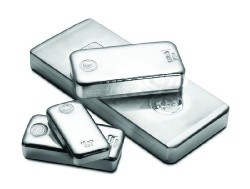 Today’s silver price is AU$31.90 but some experts say it could go much higher than $50. That means buying now could reap you returns of over 50%...
Today’s silver price is AU$31.90 but some experts say it could go much higher than $50. That means buying now could reap you returns of over 50%...
Andrew McLeod, research analyst with Lime Street Capital says at its current price, silver looks significantly under-valued.
Historically you need an average of 15 ounces of silver to buy one ounce of gold. At the moment that ratio has blown out to about 50:1, which could either mean gold is currently substantially over-valued or silver is looking extremely cheap.
To return to the historical ratio of 15:1, the price of gold would have to fall off a cliff to around $500 an ounce or the price of silver would need to climb by around $75 (more than double its current price).
If silver makes it to over $50 an ounce, buying now could result in a gain of 56%.
So what’s so good about silver?
Silver has more uses than gold. It has applications in industry, health and IT and whereas there are five billion ounces of gold above the ground, there are only one billion ounces of silver, so it is rarer.
Silver has also been massively short-sold in futures contracts and at some stage those speculators are going to have to buy silver to close those contracts. This could cause a substantial spike in the silver price at some stage so buying at current prices is considered a bargain by some experts.
McLeod says the other two “lesser” precious metals, platinum and palladium, also look over-priced at the moment, making silver look like the stand-out buying opportunity.
How can you buy silver?
You have several options if you want to invest in silver. Most major silver mining is currently done in Mexico. In Australia it’s usually mined as a by-product of other commodities such as copper and zinc. As a result you can choose to:
- buy the physical metal
- buy shares in a silver-related miner or exploration company, or
- buy an exchange-traded fund with silver exposure
Buying the physical metal involves purchasing silver bars or coins from the Perth Mint or another specialist dealer. They will, of course, take a commission by inflating the price per ounce, so shop around for the best price. You will also need to pay for storage, including insurance.
Your second option is to look for relevant shares. McLeod says Cobar Consolidated is the only dedicated silver miner currently listed on the ASX (its code is CCU).
The final option available for Australian investors is to purchase a precious-metals exchange traded fund. Again, the purchase price will be inflated by a margin, which is how the ETF provider makes its money. Note that ASX-listed ETFs have the same volatility as share prices.
What about gold?
McLeod says the performance of gold has been stellar over the past five years but that its run has come to an end. “A significant percentage of the investment community believes that gold has reached an interim high and they believe its price will fall and they’re willing to offload their gold holdings,” he says. “We still have a fair weighting to gold and believe it has the potential to put on more gains but we’re also cautious because it has had such a stellar run.”
“In Aussie dollars, the gold price is sitting at around $1,597 today and its 2011 high was around $1,800. Ultimately we think the $2,000 price peg will get taken out but you have to look at where it is right now.”
Is the risk to the upside or the downside?
“At the moment more investors are putting their money on the risk being to the downside,” he says.
“Certainly we don’t think the price of gold will fall off a cliff. We do see volatile movements from time to time of up to $150 an ounce but that’s just market manipulation from funds reversing their positions. The longer term will be slow and steady as interest in gold is still there. India and China are still massive buyers of gold.”
According to McLeod, China has huge reserves of foreign currencies (around US$12trn). “China, to protect its wealth, is buying huge gold reserves to hedge against the impact of inflation on its foreign currency reserves,” he says.
Collections: Mortgage News


Share